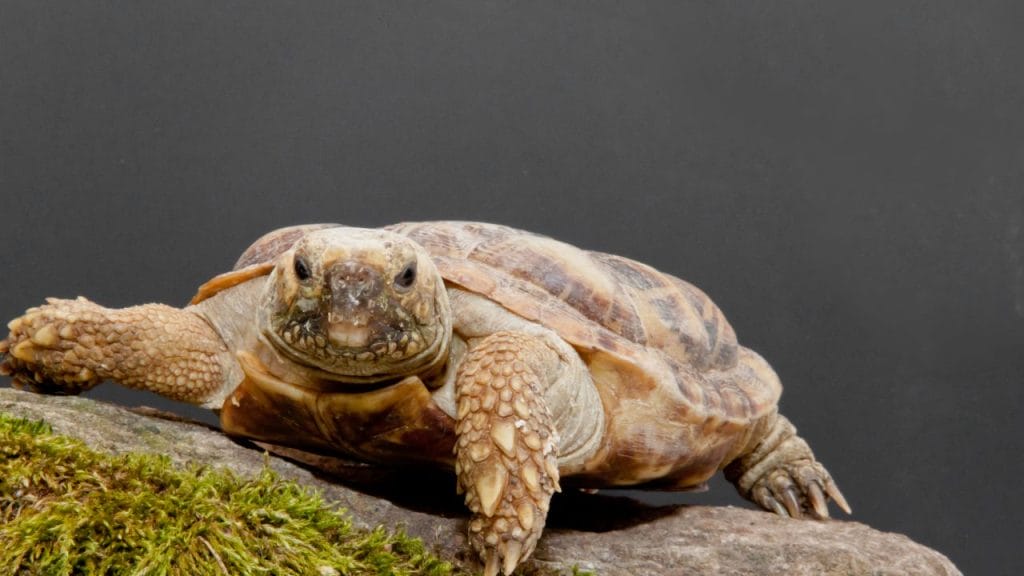Malacochersus tornieri (Pancake Tortoise)
Home > Turtle Database > Malacochersus tornieri (Pancake Tortoise)

Malacochersus tornieri, commonly known as the pancake tortoise, is a unique species of tortoise known for its flat, flexible shell. Unlike most tortoises, it is adapted to live in rocky crevices, which provide protection and a distinct lifestyle.
Native To These Regions
Kenya, TanzaniaNative Turtle Species Map – Find Turtles by Region
Scientific Classification
- Kingdom: Animalia
- Phylum: Chordata
- Class: Reptilia
- Order: Testudines
- Family: Testudinidae
- Genus: Malacochersus
- Species: Malacochersus tornieri
Common Names
- Pancake tortoise
- Softshell tortoise
This Hilarious Turtle Book Might Know Your Pet Better Than You Do
Let’s be real—most turtle care guides feel like reading a textbook written by a sleep-deprived zookeeper.
This one’s not that.
Told from the snarky point of view of a grumpy, judgmental turtle, 21 Turtle Truths You’ll Never Read in a Care Guide is packed with sarcasm, sass, and surprisingly useful insights.
And hey—you don’t have to commit to the whole thing just yet.
Grab 2 free truths from the ebook and get a taste of what your turtle really thinks about your setup, your food choices, and that weird plastic palm tree.
It’s funny, it’s honest, and if you’ve ever owned a turtle who glares at you like you’re the problem—you’ll feel seen.
Identification
Description
The pancake tortoise has a flat, soft shell with a flexible structure that allows it to squeeze into tight spaces. Its shell is brown with darker radiating patterns that provide excellent camouflage among rocks. Adults typically measure 6 to 7 inches in length.
Sexual Dimorphism
Females are generally larger than males and have a broader shell. Males have a more concave plastron, aiding in mating.
Native Origin and Distribution
Geographical Range
This species is native to East Africa, primarily found in Kenya and Tanzania. It inhabits areas with rocky outcrops, also known as kopjes.
Preferred Habitat
The pancake tortoise lives in arid savannahs with rocky crevices, which serve as its primary refuge from predators. It prefers warm, dry climates and rocky terrains that offer hiding spots.
Behavior
Feeding Habits
It is herbivorous, feeding on grasses, leaves, and succulents. Its diet varies seasonally based on available vegetation.
Predators
Natural predators include birds of prey and larger mammals. Its primary defense is its ability to flatten its body and wedge itself into rock crevices, making it difficult for predators to extract.
Reproduction
Breeding Season
Breeding typically occurs during the dry season when conditions are favorable for egg incubation.
Reproductive Method
Females lay one or two eggs per clutch, often in sandy or loose soil. Eggs incubate for four to six months, depending on environmental conditions.
Conservation
Extinction Status
The pancake tortoise is currently listed as Critically Endangered by the IUCN.
Threats
Habitat destruction, collection for the pet trade, and slow reproductive rates pose significant threats to its survival.
Conservation Measures
Efforts include habitat protection, stricter regulation of the pet trade, and captive breeding programs to increase population numbers.
Economic Importance
This species is valued in the exotic pet trade, though overharvesting has significantly impacted wild populations. Additionally, it plays a role in local ecosystems by controlling vegetation growth.
Interesting Facts
- The pancake tortoise’s flexible shell is a rare adaptation among tortoises.
- It can rapidly climb rocky surfaces, a skill uncommon for most tortoise species.
- Unlike many tortoises, it doesn’t rely on burrowing but instead uses crevices for shelter.

About Author
Muntaseer Rahman started keeping pet turtles back in 2013. He also owns the largest Turtle & Tortoise Facebook community in Bangladesh. These days he is mostly active on Facebook.











